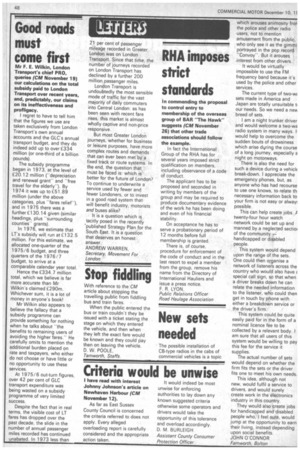Good roads must come first
Page 78

If you've noticed an error in this article please click here to report it so we can fix it.
Mr F. E. Wilkin, London Transport's chief PRO, queries (CM November 19) our calculations on the total subsidy paid to London Transport over recent years, and, predictably, our claims on its ineffectiveness and profligacy.
I regret to have to tell him that the figures we use are taken exclusively from London Transport's own annual accounts and the GLC's annual transport budget, and they do indeed add up to over £334 million (or one-third of a billion pounds).
The subsidy programme began in 1973, at the level of £20.12 million (-depreciation and renewal grantand "free travel for the elderly"). By 1974 it was up to £51.89 million (under the above categories, plus ''fares relief"), and in 1975 there was a further .E1 30,14 given (similar headings, plus "surrounding counties" grants).
In 1976, we estimate that LT's subsidy will, run at £132.5 million. For this estimate, we allocated one-quarter of the 1975/6 budget, and three quarters of the 1976/7 budget, to arrive at a comparable calendar year total.
Hence the £334.7 million total, which we believe is far more accurate than Mr Wilkins claimed f:290m. Whichever sum, it is a lot of money in anyone's book!
Mr Wilkin also appears to believe the fallacy that a subsidy programme can provide something for nothing when he talks about "the benefits to remaining users of avoiding the higher fares.He carefully omits to mention the additional burden placed on rate and taxpayers, who either do not choose or have little or no opportunity to use these services.
At 1975/6 out-turn figures, over 42 per cent of GLC transport expenditure was being wasted on a subsidy programme of very limited success.
Despite the fact that in real terms, the visible cost of LT fares has dropped over the past decade, the slide in the number of annual passenger miles recorded has continued unabated. In 1973 less than 21 per cent of passenger mileage recorded in Greater London was on London Transport. Since that time, the number of journeys recorded on London Transport has declined by a further 200 million passenger miles.
London Transport is undoubtedly the most sensible mode of traffic for the vast majority of daily commuters into Central London as has been seen with recent fare rises, this market is almost wholly captive and non-price responsive.
But most Greater London journeys, whether for business or leisure purposes, have more complex routes and demands that can ever been met by a fixed track or route systems. In the end, the question that must be faced is: which is better for the future of London? To continue to underwrite a service used by fewer and fewer Londoners, or to invest in a good road system that will benefit industry, motorists and buses alike?
It is a question which is tacitly posed in the recently 'published Strategy Plan for the South East. It is a question that deserves an honest answer.
ANDREW WARREN, Secretary, Movement For London
























































































































